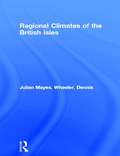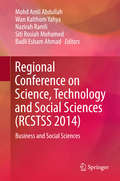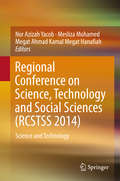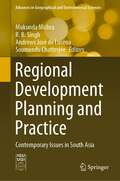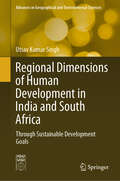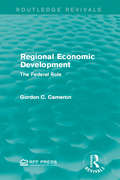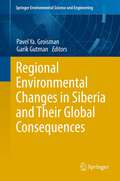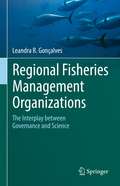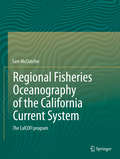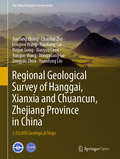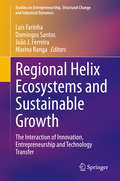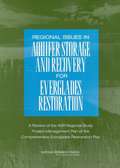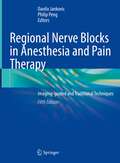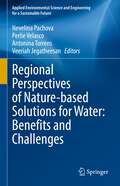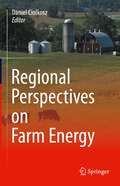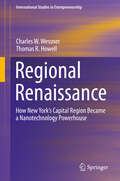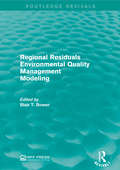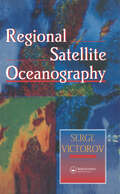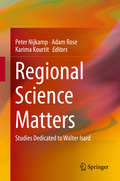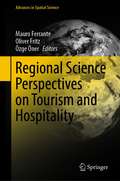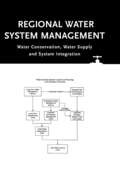- Table View
- List View
Regional Assessment of Climate Change in the Mediterranean
by Antonio Navarra Laurence TubianaThis is the third volume of a three-volume final report, which thoroughly describes, synthesizes and analyzes the results of the four-year Integrated Research Project CIRCE - Climate Change and Impact Research: Mediterranean Environment, funded by the EU 6th Framework Programme. Conducted under the auspices of the National Institute of Geophysics and Volcanology in Rome, Italy, the study was designed to predict and to quantify the physical impacts of climate change in the Mediterranean, and to assess the most influential consequences for the population of the region.
Regional Climates of the British Isles
by Julian Mayes Dennis WheelerGlobal climate and the effects of global warming are commanding unprecedented interest as climates grow more dynamic and changeable. How does global warming change patterns of climate? Why is the weather and climate of the British Isles so variable? Regional Climates of the British Isles presents a comprehensive and up-to-date survey of the diverse climate of the British Isles. <p><p> Examining the ways in which regional climates evolve from the interplay of meteorological conditions and geography of the British Isles, leading climatologists provide detailed explanations of the climatic characteristics of eleven regions of the British Isles. Climatic distinctiveness and local weather contrasts are described for each region, together with a summary of climatic data from 1961 to the present. <p> Reviewing the history and causes of climatic change and evaluating regional models, Regional Climates of the British Isles offers an important analysis of climatic variations. Examining future climatic change and its likely consequences, the authors acknowledge the need for regionally diverse responses to the greenhouse effect.
Regional Conference on Science, Technology and Social Sciences (RCSTSS #2014)
by Mohd Amli Abdullah Wan Kalthom Yahya Nazirah Ramli Siti Rosiah Mohamed Badli Esham AhmadThis book features more than 95 papers that were presented at the bi-annual Regional Conference on Science, Technology and Social Sciences, RCSTSS 2014, which was organized by Universiti Teknologi MARA Pahang. It covers topics ranging from communications studies, politics, psychology, education, religious studies as well as business and economics. The papers, which have been carefully reviewed, include research conducted by academicians locally, regionally and globally. They detail invaluable insights on the important roles played by the various disciplines in science, technology and social sciences. Coverage includes accounting, art and design, business, communication, economics, education, finance, humanity, information management, marketing, music, religion, social sciences and tourism. Throughout, clear illustrations, figures and diagrams complement the research. The book is a significant point of reference to academicians and students who want to pursue further research in their respective fields. It also serves as a platform to disseminate research findings as a catalyst to bring out positive innovations on the development of the region.
Regional Conference on Science, Technology and Social Sciences (RCSTSS #2014)
by Nor Azizah Yacob Mesliza Mohamed Megat Ahmad Kamal Megat HanafiahThis book gathers selected science and technology papers that were presented at the 2014 Regional Conference of Sciences, Technology and Social Sciences (RCSTSS 2014). The bi-annual Conference is organized by Universiti Teknologi MARA Pahang, Maylasia. The papers address a broad range of topics including architecture, life sciences, robotics, sustainable development, engineering, food science and mathematics. The book serves as a platform for disseminating research findings, as a catalyst to inspire positive innovations in the development of the region. The carefully-reviewed papers in this volume present research by academicians of local, regional and global prominence. Out of more than 200 manuscripts presented at the conference by researchers from local and foreign universities and institutions of higher learning, 64 papers were chosen for inclusion in this publication. The papers are organized in more than a dozen broad categories, spanning the range of scientific research: * Engineering * Robotics * Mathematics & Statistics * Computer & Information Technology * Forestry * Plantation & Agrotechnology * Sports Science & Recreation * Health & Medicine * Biology * Physics * Food Science * Environment Science & Management * Sustainable Development * Architecture The book provides a significant point of reference for academics, researchers and students in many fields who need deeper research.
Regional Conference on Science, Technology and Social Sciences: Theoretical And Applied Sciences (RCSTSS #2016)
by Nor Azizah Yacob Nur Asmaliza Mohd Noor Nor Yuziah Mohd Yunus Rahmah Lob Yussof Shaikh Abdul Karim Yamani ZakariaThis book gathers selected theoretical and applied science papers presented at the 2016 Regional Conference of Sciences, Technology and Social Sciences (RCSTSS 2016), organized biannually by the Universiti Teknologi MARA Pahang, Malaysia. Addressing a broad range of topics, including architecture, computer science, engineering, environmental and management, furniture, forestry, health and medicine, material science, mathematics, plantation and agrotechnology, sports science and statistics, the book serves as an essential platform for disseminating research findings, and inspires positive innovations in the region’s development.The carefully reviewed papers in this volume present work by researchers of local, regional and global prominence. Taken together, they offer a valuable reference guide and point of departure for all academics and students who want to pursue further research in their respective fields.
Regional Development Planning and Practice: Contemporary Issues in South Asia (Advances in Geographical and Environmental Sciences)
by Soumendu Chatterjee R. B. Singh Mukunda Mishra Andrews José de LucenaThis book, through a bunch of systematic and analytical notes and scientific commentaries, acquaints the readers with the innovative methods of regional development, measurement of the development in regional scale, regional development models, and policy prescriptions. Conceptualizing development as a regional process is a geographer's brainchild, and the sense of region has long been rooted deeply in the fundamental research practices that geographers are accustomed to. The geographical perspective of regions entails conceptualizing them nested horizontally as the formal region and hierarchical relationships in space with spatial flows or interactions as the functional region. In geographical research, the region works as a tool by serving as a statistical unit of analysis. More importantly, however, regions serve as the fundamental spatial units of management and planning by specifying a territory or a part of it for which a certain spatial development or regulatory plan is sought. This book addresses the complex processes in different regions of the world, particularly South Asia, to perceive the regional development planning involved and the sustainable management practiced there. The book is a useful resource for socio-economic planners, policymakers, and policy researchers.
Regional Dimensions of Human Development in India and South Africa: Through Sustainable Development Goals (Advances in Geographical and Environmental Sciences)
by Utsav Kumar SinghThis book offers a comparative study of the progress made by two regional economies with many similarities—India and South Africa—in pursuit of human development by applying Sustainable Development Goals (SDGs). In this effort, book traverses the stages in public policy from planning to implementation, and from reach to range, in pursuit of inclusive growth and well-being for all. The book includes cross-national qualitative as well as quantitative studies and deeper analyses of India, and South Africa in respect of long-term development goals. This book attempted to solve the following puzzle: despite the stupendous growth rate, why is India's performance lower than South Africa's in terms of human development indicators? This book addresses this puzzle by drawing attention to welfare approaches. These two countries have unique federal structures that uphold the unbalanced states together, and this book argues that uneven development challenges need asymmetric strategies, contrary to the axiom that the SDGs are indivisible. Further advancement of India and South Africa depends on transforming their quantity (large youth population) into quality (human capital). Both countries are also striving to create platforms to unleash human potential, which is critically examined.
Regional Economic Development: The Federal Role (Routledge Revivals)
by Gordon C. CameronFirst published in 1970, Regional Economic Development: The Federal Role examines the economic viability of depressed areas and regions. This book questions whether there is adequate justification, on national economic grounds, for Federal involvement with distressed area revitalisation and looks at the main guidelines for intervention in relation to typology of distressed areas. This title is an ideal resource for students interested in politics, macroeconomics, and federal policies concerning the revitalisation of distressed areas and economies.
Regional Environmental Changes in Siberia and Their Global Consequences
by Garik Gutman Pavel Ya. GroismanThis volume presents a state-of-the-art assessment of the Earth's climate system in Siberia and relationships between climate, ecosystems and people in that region. Changes in climatic variables and land cover in Siberia are among the earliest indicators of the Earth's response to climate warming. The volume is a compilation of results from studies on climate, land-cover and land-use changes and their interactions with biogeochemical and water cycles, atmospheric aerosol, and human and wildlife populations in Siberia. Regional changes in Siberia are predicted to affect climate and people on a global scale. NASA, the Russian Academy of Sciences, and several European institutions have supported these studies. The primary supporter of the projects that produced the results compiled in this volume is the NASA Land-Cover/Land-Use Change Program, hence most studies use remote sensing in their research. The chapters in this volume were written by an international team of scientists from the USA, Europe and Russia under the auspices of the Northern Eurasia Earth Science Partnership Initiative (NEESPI). This book will be of interest to those involved in studying recent and ongoing changes in Siberia, be they senior scientists, early career scientists or students.
Regional Fisheries Management Organizations: The interplay between governance and science
by Leandra R. GonçalvesThis book analyzes empirical data from three specific Regional Fisheries Management Organizations (RFMOs) designed to establish rules for the conservation and management of fish stocks in the ocean, in order to assess their effectiveness in converting science into policy for the recovery and maintenance of fishery populations. The three RFMOs discussed are the CCAMLR (Convention for the Conservation of Antarctic Marine Living Resources), the ICCAT (International Commission for the Conservation of Atlantic Tunas) and the CCSBT (Commission for the Conservation of Southern Bluefin Tuna). The book seeks to understand when governments choose to listen to science, and establishes a framework to examine the institutional designs currently in place to accommodate RFMO policy suggestions and the conditions under which they are implemented successfully. The study will be of interest to academics and professionals broadly interested in global environmental governance and international relations, and will specifically appeal to policymakers, conservationists, and environmental researchers interested in fishery management and policy at the global and regional scale. Gonçalves provides an accessible and comprehensive analysis of RMFOs. She offers valuable insights into the role of science and politics in shaping sustainable fisheries policies for the open oceans. ---Peter M Haas, Professor Department of Political Science, University of Massachusetts AmherstAs envisaged by the UN Decade of Ocean proclamation, this book is an important and sincere effort, hopefully to be accompanied by many others to come during this promising decade, that will help to build a common framework to ensure that ocean science can support countries and the international community in creating improved conditions for the sustainable development of our cherished Ocean.---Fabio H. Hazin - Professor at Federal Rural University of Pernambuco, Brazil
Regional Fisheries Oceanography of the California Current System
by Sam McclatchieThe California Current System is one of the best studied ocean regions of the world, and the level of oceanographic information available is perhaps only surpassed by the northeast and northwest Atlantic The current literature (later than 1993) offers no comprehensive, integrated review of the regional fisheries oceanography of the California Current System. This volume summarizes information of more than 60-year California Cooperative Oceanic Fisheries Investigation (CalCOFI) While providing a large bibliography, the intent was to extract themes relevant to current research rather than to prepare a compendious review of the literature The work presents a useful review and reference point for multidisciplinary fisheries scientists and biological oceanographers new to working in the California Current System, and to specialists wishing to access information outside their core areas of expertise. In addition it aims to deliver an up to date reference to the current state of knowledge of fisheries oceanography in the California Current System.
Regional Fisheries Oceanography of the California Current System: The CalCOFI Program
by Sam McClatchieThe California Current System is one of the best studied ocean regions of the world, and the level of oceanographic information available is perhaps only surpassed by the northeast and northwest Atlantic. The current literature (later than 1993) offers no comprehensive, integrated review of the regional fisheries oceanography of the California Current System. This volume summarizes information of more than 60-year California Cooperative Oceanic Fisheries Investigation (CalCOFI). While providing a large bibliography, the intent was to extract themes relevant to current research rather than to prepare a compendious review of the literature. The work presents a useful review and reference point for multidisciplinary fisheries scientists and biological oceanographers new to working in the California Current System, and to specialists wishing to access information outside their core areas of expertise. In addition, the first editioin published in 2014 aimed to deliver an up to date reference to the current state of knowledge of fisheries oceanography in the California Current System. The second edition adds some new sections, and data visualizations. The most important new material is included in the perspectives on CalCOFI chapter. New vignettes have been added for Reuben Lasker, Ed Brinton, Abraham Fleminger, Elizabeth Venrick, and Andrew Leising. The vignette for Noelle Bowlin has been updated to reflect her position as the current NOAA lead for the CalCOFI program, and a vignette has also been added for Sam McClatchie.
Regional Geological Survey of Hanggai, Xianxia and Chuancun, Zhejiang Province in China: 1:50,000 Geological Maps (The China Geological Survey Series)
by Jianfang Zhang Chaohui Zhu Longwu Wang Xiaoliang Cai Ruijun Gong Xiaoyou Chen Jianguo Wang Mingguang Gu Zongyao Zhou Yuandong LiuThis Open Access book introduces readers to the regional geology of Hanggai, Xianxia and Chuancun, the area between China's northern Zhejiang Province and southern Anhui Province and explores the strata, magmatic rocks and tectonic structures in 1:50,000 scale geological maps. Based on studies of multiple stratigraphic divisions, the standard stratigraphic section of the upper Ordovician Hirnantian in the lower Yangtze region is established, revealing for the first time numerous “Burgess Shale-type” sponge fossils in Hirnantian strata and identifying 10 grapholite fossil belts and various fossil categories, including chitin, trilobites, gastropods, brachiopods, and cephalopods. Moreover, the book identifies for the first time Late Ordovician volcanic events in northern Zhejiang province. The work represents a major contribution to research on Paleozoic strata in the Lower Yangtze region, and sheds new light on understanding the Hirnantian glacial event and biological extinction event in South China by providing a high-precision time scale. In addition, the book opens an important avenue for future research on sponge evolution after the Cambrian life explosion. As such, it offers a unique and valuable asset for researchers and graduate students alike.
Regional Helix Ecosystems and Sustainable Growth: The Interaction of Innovation, Entrepreneurship and Technology Transfer (Studies on Entrepreneurship, Structural Change and Industrial Dynamics)
by João J. Ferreira Luís Farinha Marina Ranga Domingos SantosThis book discusses the importance of innovation and entrepreneurial ecosystems in supporting regional competitiveness. It also encourages academics, business professionals and policy-makers to rethink innovation ecosystems as drivers of regional competitiveness, demonstrating the complex interactions between regional economic and social actors, and their impact on regional competitiveness. Further, the book examines the role of entrepreneurship and innovation policies in different regions (e.g. lagging regions, rural regions, etc.), and describes critical success factors in multi-level technologies and innovation policies and strategies.
Regional Issues In Aquifer Storage And Recovery For Everglades Restoration
by Committee on Restoration of the Greater Everglades EcosystemThe report reviews a comprehensive research plan on Everglades restoration drafted by federal and Florida officials that assesses a central feature of the restoration: a proposal to drill more than 300 wells funneling up to 1. 7 billion gallons of water a day into underground aquifers, where it would be stored and then pumped back to the surface to replenish the Everglades during dry periods. The report says that the research plan goes a long way to providing information needed to settle remaining technical questions and clearly responds to suggestions offered by scientists in Florida and in a previous report by the Research Council.
Regional Nerve Blocks in Anesthesia and Pain Therapy: Imaging-guided and Traditional Techniques
by Danilo Jankovic Philip PengThis comprehensive atlas, which includes a wealth of illustrations and anatomic pictures created by the editors, covers a broad range of both regional anesthesia and pain intervention techniques, including neuromodulation. The book is unique in that it covers ultrasound and fluoroscopic-guided techniques, as well as traditional landmark-guided techniques. The authors and editors are internationally renowned experts, and share extensive theoretic and practical insights into regional anesthesia, pain therapy and anatomic sciences for everyday practice.The book addresses the application of ultrasound and fluoroscopic guidance for pain interventions and provides detailed coverage of ultrasound-guided and landmark-guided regional anesthesia. The book represents a detailed guide to the application of regional anesthesia and pain medicine; furthermore, examples of medico-legal documentation are also included in this edition. The 5th edition of Regional Nerve Blocks in Anesthesia and Pain Medicine is practically oriented and provides essential guidelines for the clinical application of regional anesthesia. It is intended for anesthesiologists and all professionals engaged in the field of pain therapy such as pain specialists, surgeons, orthopedists, neurosurgeons, neurologists, general practitioners, and nurse anesthetists.
Regional Perspectives of Nature-based Solutions for Water: Benefits and Challenges (Applied Environmental Science and Engineering for a Sustainable Future)
by Veeriah Jegatheesan Nevelina Pachova Perlie Velasco Antonina TorrensNature-based solutions (NbS) are solutions inspired or supported by nature. They include ecosystem conservation and restoration measures, as well as the creation or enhancement of natural processes in man-made ecosystems, such as cities. Recent interest in NbS has emphasized their importance for urban water management and cities across the world have begun to experiment with them. Experiences from different contexts, however, are not adequately captured and understood. This book aims to address this gap by compiling case studies and reviews that explore NbS for urban water management from different regions and perspectives and highlight emerging challenges and opportunities for harnessing their potential.
Regional Perspectives on Farm Energy
by Daniel CiolkoszThis book examines the characteristics and opportunities for farm energy in the northeast quadrant of the United States, with attention to energy use, strategic energy management, and energy production by solar, wind, biomass, and other means. Throughout, the distinct characteristics of the region and their impact on energy solutions are discussed, and the outlook for future energy strategies is considered. Farm energy production and use are topics of increasing interest, as the need for improved efficiency and the opportunity for sustainable energy production both drive agricultural enterprises to reduce energy use and pursue opportunities for renewable energy production and use on the farm. However, the unique regional characteristics of agriculture make it challenging to apply a single approach to all situations.
Regional Renaissance: How New York’s Capital Region Became a Nanotechnology Powerhouse (International Studies in Entrepreneurship #42)
by Charles W. Wessner Thomas R. HowellThis book examines ways in which formerly prosperous regions can renew their economy during and after a period of industrial and economic recession. Using New York’s Capital Region (i.e., Albany, Troy, Schenectady, etc.) as a case study, the authors show how entrepreneurship, innovation, investment in education, research and political collaboration are critical to achieving regional success. In this way, the book provides other regions and nations with a real-life model for successful economic development. In the past half century, the United States and other nations have seen an economic decline of formerly prosperous regions as a result of new technology and globalization. One of the hardest-hit United States regions is Upstate New York or “the Capital Region”; it experienced a demoralizing hemorrhage of manufacturing companies, jobs and people to other regions and countries. To combat this, the region, with the help of state leaders, mounted a decades-long effort to renew and restore the region’s economy with a particular focus on nanotechnology. As a result, New York’s Capital Region successfully added thousands of well-paying, skill-intensive manufacturing jobs. New York’s success story serves as a model for economic development for policy makers that includes major public investments in educational institutions and research infrastructure; partnerships between academia, industry and government; and creation of frameworks for intra-regional collaboration by business, government, and academic actors. Featuring recommendations for best practices in regional development policy, this book is appropriate for scholars, students, researchers and policy makers in regional development, innovation, R&D policy, economic development and economic growth.
Regional Residuals Environmental Quality Management Modeling (Routledge Revivals)
by Blair T. BowerOriginally published in 1977, this title provides an overview of regional residuals-environmental quality management (REQM). Edited by Blair T. Bower, this volume offers insights on the analytical problems faced in developing useful information for societal decisions on REQM. It is a valuable resource for policy makers and students interested in environmental issues.
Regional Satellite Oceanography
by Serge VictorovThis work addresses the whole range of problems relating to the application of satellite technology to studies of regional seas and sea phenomona - the Gulf Stream, the Kuroshia Current - and coastal zones. It argues that to emphasize global applications is to fail to take into account fundamental idiosyncracies specific to the regional perspective
Regional Scale Ecological Risk Assessment: Using the Relative Risk Model
by Wayne G. LandisAs debates over how relative risk can be used to shape landscape-scale environmental management intensify, Regional-Scale Risk Assessment demonstrates the capabilities of RRM using nine case studies in the Pacific Northwest, Pennsylvania, Brazil, and Tasmania. The authors use a process of ranking and filters to interrelate different kinds of risks
Regional Science Matters
by Peter Nijkamp Karima Kourtit Adam RoseThis volume is a collection of fresh and novel contributions to regional science. They commemorate the scientific inheritance of the founding father of regional science, the late Walter Isard. All papers are written by well-known scholars in the field and serve to highlight the great importance of regional science theory and methodology for a better understanding of current spatial and environmental problems throughout our planet. The book showcases a multidisciplinary panorama of modern regional science research and presents new insights by applying regional science approaches.
Regional Science Perspectives on Tourism and Hospitality (Advances in Spatial Science)
by Mauro Ferrante Oliver Fritz Özge ÖnerThis book approaches the tourism and hospitality industry from a regional science perspective. By analyzing the spatial context of tourist travels, the hospitality sector, and the regional impacts of tourist activities, it demonstrates the value of the regional science paradigm for understanding the dynamics and effects of tourism and hospitality-related phenomena. Written by leading regional science scholars from various countries as well as professionals from organizations such as OECD and AirBnB, the contributions address topics such as migration, new types of accommodation, segmentation of tourism demand, and the potential use of tracking technologies in tourism research.The content is divided into five parts, the first of which analyzes spatial effects on the development of firms in the tourism industry, while the second approaches temporal and spatial variability in tourism through analytical regional science tools. The broader economic and social impacts of tourism are addressed in part three. Part four assesses specific tourism segments and tourist behaviors, while part five discusses environmental aspects and tourism destination policies. The book will appeal to scholars of regional and spatial science and tourism, as well as tourism specialists and policymakers interested in developing science and evidence-based tourism policies.
Regional Water System Management: Water Conservation, Water Supply and System Integration
by Enrique CabreraThe spectacular industrial and economic development of the twentieth century was achieved at a considerable environmental cost. The increasingly precarious position of water, the most valuable of natural resources, reflects this trend. Today we have come to realise that concepts of sustainable development need to

